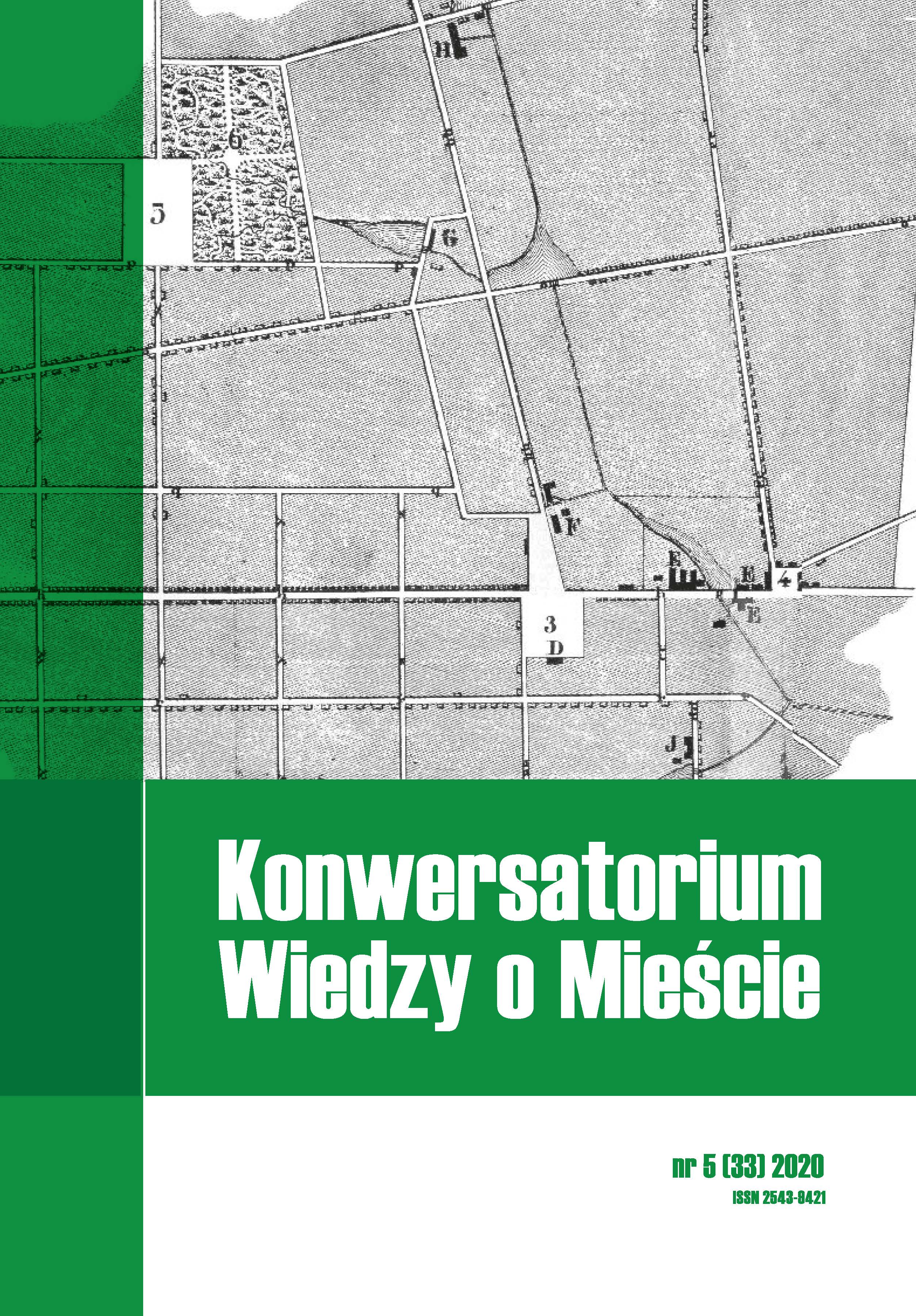Stadion piłkarski w przestrzeni miasta: przemiany lokalizacji dużych obiektów infrastruktury piłkarskiej
DOI:
https://doi.org/10.18778/2543-9421.05.09Słowa kluczowe:
stadion, infrastruktura sportu, infrastruktura piłkarska, wzorce lokalizacji, użytkowanie ziemiAbstrakt
W artykule omówiono zmiany w przestrzennym rozmieszczeniu dużych obiektów infrastruktury sportowej (stadionów) umożliwiających organizację rozgrywek piłkarskich. Celem pracy jest wskazanie kierunków zmian przestrzennego rozmieszczenia dużych stadionów piłkarskich w miastach oraz identyfikacja cech zagospodarowania ich bezpośredniego sąsiedztwa. Badaniem objęto 895 stadionów piłkarskich, mieszczących przynajmniej 10 tys. widzów oraz ich otoczenie. Uwzględniono stadiony z 47 (na 55) państw należących do Unii Europejskich Związków Piłkarskich (UEFA). Przeprowadzona analiza cech zagospodarowania bezpośredniego sąsiedztwa stadionów dała możliwość określenia zarówno korzyści, jak i potencjalnych trudności wynikających z tworzenia coraz większych obiektów w coraz większej odległości od centralnej części miasta. W pracy wykazano, że w przypadku wszystkich wyróżnionych kategorii wielkościowych miast wzrosła średnia odległość położenia stadionów od centrum. Stadiony budowane współcześnie (powstałe po 2000 r.) wznoszone są na obszarach peryferyjnych miasta, a w sąsiedztwie tych obiektów rzadziej występuje zabudowa mieszkaniowa, zaś standardem stają się duże przestrzenie parkingowe.
Bibliografia
Ahlfeldt, G., Maenning, W. (2010). Stadium architecture and urban development from the perspective of urban economics. International Journal of Urban and Regional Research, 34 (3), 629–646. https://doi.org/10.1111/j.1468-2427.2010.00908.x
Google Scholar
DOI: https://doi.org/10.1111/j.1468-2427.2010.00908.x
Bairner, A. (2006). Titanic town: Sport, space and the re-imag(in)ing of Belfast. City & Society, 18 (2), 159–179. https://doi.org/10.1525/city.2006.18.2.159
Google Scholar
DOI: https://doi.org/10.1525/city.2006.18.2.159
Bale, J. (1990). In the shadow of the stadium: Football grounds as urban nuisances. Geography, 75 (4), 325–334.
Google Scholar
Bale, J. (1993a). Sport, space and the city. Londyn: Routledge.
Google Scholar
Bale, J. (1993b). The spatial development of the modern stadium. International Review for the Sociology of Sports, 28 (2–3), 122–133. https://doi.org/10.1177/101269029302800204
Google Scholar
DOI: https://doi.org/10.1177/101269029302800204
Delaney, K., Eckstein, R. (2012). Local growth coalitions, publicly subsidized sports stadiums, and social inequality. Humanity& Society, 30 (1), 84–108. https://doi.org/10.1177/016059760603000106
Google Scholar
DOI: https://doi.org/10.1177/016059760603000106
Feddersen, A., Maennig, W. (2009). Arenas versus multifunctional stadiums: Which do spectators prefer? Journal of Sports Economics, 10 (2), 180–191. https://doi.org/10.1177/1527002508323821
Google Scholar
DOI: https://doi.org/10.1177/1527002508323821
Frosdick, S., Newton, R. (2006). The nature and extent of football hooliganism in England and Wales. Soccer & Society, 7 (4), 403–422. https://doi.org/10.1080/14660970600905703
Google Scholar
DOI: https://doi.org/10.1080/14660970600905703
Giulianotti, R. (2005). Sport spectators and the social consequences of commodification. Journal of Sport and Social Issues, 29 (4), 386–410. https://doi.org/10.1177/0193723505280530
Google Scholar
DOI: https://doi.org/10.1177/0193723505280530
Google Earth (2020). Pobrane z: https://www.google.pl/intl/pl/earth/ (30.11.2020).
Google Scholar
Kozłowska, M. (2008). Imprezy sportowe w Bydgoszczy jako przykład atrakcji turystycznej dużego miasta. W: I. Jażdżewska (red.), XXI Konwersatorium wiedzy o mieście (s. 227–238). Łódź: Wydawnictwo Uniwersytetu Łódzkiego.
Google Scholar
Lasch, C. (1988). The degradation of sport. W: W.J. Morgan, K. V. Meier (red.), Philosophic inquiry in sport (s. 403–417). Champaign: Human Kinetics.
Google Scholar
Lewis, R. (2012). From the “Phoenix of Legends” to the “Ultimate Monument” of the times: Stadia, spectators, and urban development in postwar Paris. Journal of Urban History, 38 (2), 319–335. https://doi.org/10.1177/0096144211429380
Google Scholar
DOI: https://doi.org/10.1177/0096144211429380
London stadium, Stratford. Capacity increase – transport statement (2019). Pobrane z: http://planningregister.londonlegacy.co.uk/swift/MediaTemp/8402-148687.pdf (30.11.2020).
Google Scholar
Manchester City council (2014). Pobrane z: https://democracy.manchester.gov.uk/Data/Planning%20and%20Highways%20Committee/20140213/Agenda/Item_15___Eithad_Stadium_Etihad_Campus_Manchester.pdf (30.11.2020).
Google Scholar
Nelson, A. (2002). Locating major league stadiums where they can make a difference. Public Works Management & Policy, 7 (2), 98–114. https://doi.org/10.1177/108772402236952
Google Scholar
DOI: https://doi.org/10.1177/108772402236952
Northumberland development project. Stadium major event day trans- port assessment planning 2015 (2015). Pobrane z: http://www.planningservices.haringey.gov.uk/portal/servlets/AttachmentShowServlet?ImageName=748287 (30.11.2020).
Google Scholar
Owen, J. (2003). The stadium game: Cities versus teams. Journal of Sports Economics, 4 (183), 182–202. https://doi.org/10.1177/1527002503251710
Google Scholar
DOI: https://doi.org/10.1177/1527002503251710
Rąpalski, P. (2014). Wydatki na stadion Wisły nie mają końca. Teraz znów trzeba go poprawić i płacić. Pobrane z: https://gazetakrakowska.pl/wydatki-na-stadion-wisly-nie-maja-teraz-znow-trzeba-go-poprawic-i-placic/ar/3593097 (30.11.2020).
Google Scholar
Rąpalski, P., Serafin, D. (2014). Ponad połowa krakowian nie chce, by miasto utrzymywało stadiony Wisły i Cracovii. Pobrane z: https://gazetakrakowska.pl/ponad-polowa-krakowian-nie-chce-by-miasto-utrzymywalo-stadiony-wisly-i-cracovii/ar/3640232 (30.11.2020).
Google Scholar
Robinson, J.S.R. (2010). The place of the stadium: English football beyond the fans. Sport in Society, 13 (6), 1012–1026. https://doi.org/10.1080/17430437.2010.491270
Google Scholar
DOI: https://doi.org/10.1080/17430437.2010.491270
Serafin, D. (2019). Stadion Wisły jak finansowa studnia bez dna. Ma wypięknieć za 70 mln zł. Pobrane z: https://wiadomosci.onet.pl/krakow/stadion-wisly-w-krakowie-jaki-bedzie-koszt-remontu/j601658 (30.11.2020).
Google Scholar
Southampton Football Club. Transportation plan 2006–2007 (2007). Pobrane z: http://www.southampton.gov.uk/moderngov/Data/Planning%20and%20Rights%20of%20Way%20Panel/20061107/Agenda/ShowDocumentaspPKID2510.pdf (30.11.2020).
Google Scholar
van Steen, P. J. M., Pellenbarg, P. H. (2008). Sport and space in the Netherlands. Tijdschrift voor economische en sociale geografie, 99 (5),649–661. https://doi.org/10.1111/j.1467-9663.2008.00500.x
Google Scholar
DOI: https://doi.org/10.1111/j.1467-9663.2008.00500.x
Traffic and transport assessment report (2020). Pobrane z: https://consult.sdublincoco.ie/en/system/files/materials/4438/T002%20-%20Traffic%20and%20transport%20assessment.pdf (30.11.2020).
Google Scholar
Transfermarkt (2020). Pobrane z: https://www.transfermarkt. com/ (21.11.2020).
Google Scholar
Transport study update (2013). Pobrane z: http://www.archive.brentfordcommunitystadium.com/wp-content/uploads/2013/04/130120-LRLG-Slide-Inputs-FINAL-100dpi. pdf (30.11.2020).
Google Scholar
Trzepacz, P. (2015a). Maracana i Camp Nou. Jak zarabiać na stadionach po meczu? Inwestor, 2 (97), 34–36.
Google Scholar
Trzepacz, P. (2015b). Rewitalizacja przez sport. Inwestor, 6 (101), 28–30.
Google Scholar
Tuan, Y.-F. (1974). Topophilia: a study of environmental perception and values. Englewood Cliffs: Prentice-Hall.
Google Scholar
Twardzik, M. (2016). Oddziaływanie galerii handlowych na śród- miejskie ulice handlowe Katowic. Acta Universitatis Lodziensis. Folia Geographica Socio-Oeconomica, 23, 67–85. https://doi.org/10.18778/1508-1117.23.04
Google Scholar
DOI: https://doi.org/10.18778/1508-1117.23.04
Tziralis, G., Tolis, A., Tatsiopoulos, I., Aravossis, K. (2008). Sustainability and the Olympics: The case of Athens 2004. International Journal of Sustainable Development and Planning, 3 (2), 132–146. https://doi.org/10.2495/SDP-V3-N2-132-146
Google Scholar
DOI: https://doi.org/10.2495/SDP-V3-N2-132-146
Witherick, M., Warn, S. (2003). The geography of sport and leisure. Cheltenham: Nelson Thornes Ltd.
Google Scholar
Wolaniuk, A. (2012). Centra miasta. W: S. Liszewski (red.), Geografia urbanistyczna (s. 303–341). Warszawa: Wydawnictwo Naukowe PWN.
Google Scholar
Pobrania
Opublikowane
Jak cytować
Numer
Dział
Licencja

Utwór dostępny jest na licencji Creative Commons Uznanie autorstwa – Użycie niekomercyjne – Bez utworów zależnych 4.0 Międzynarodowe.









